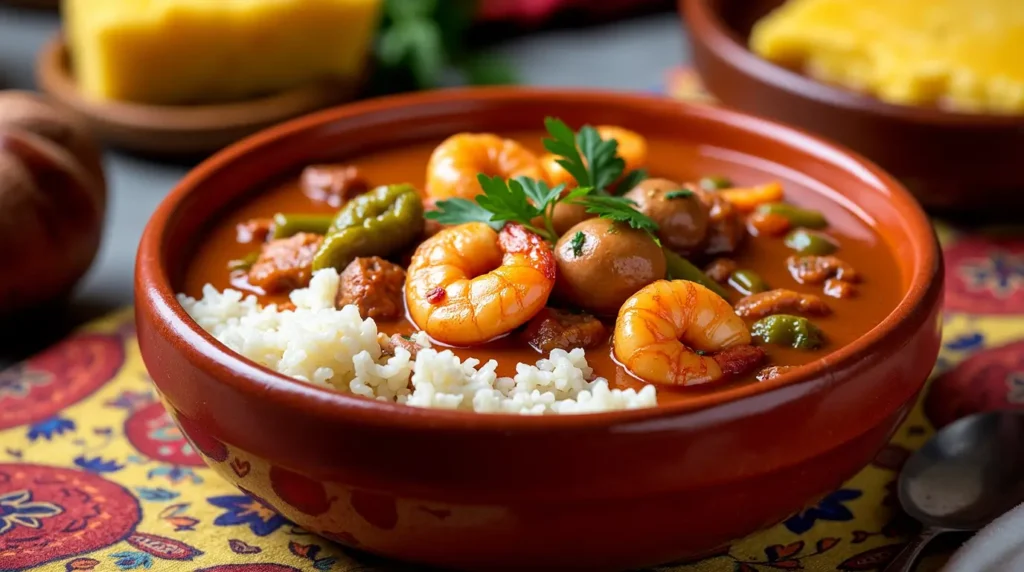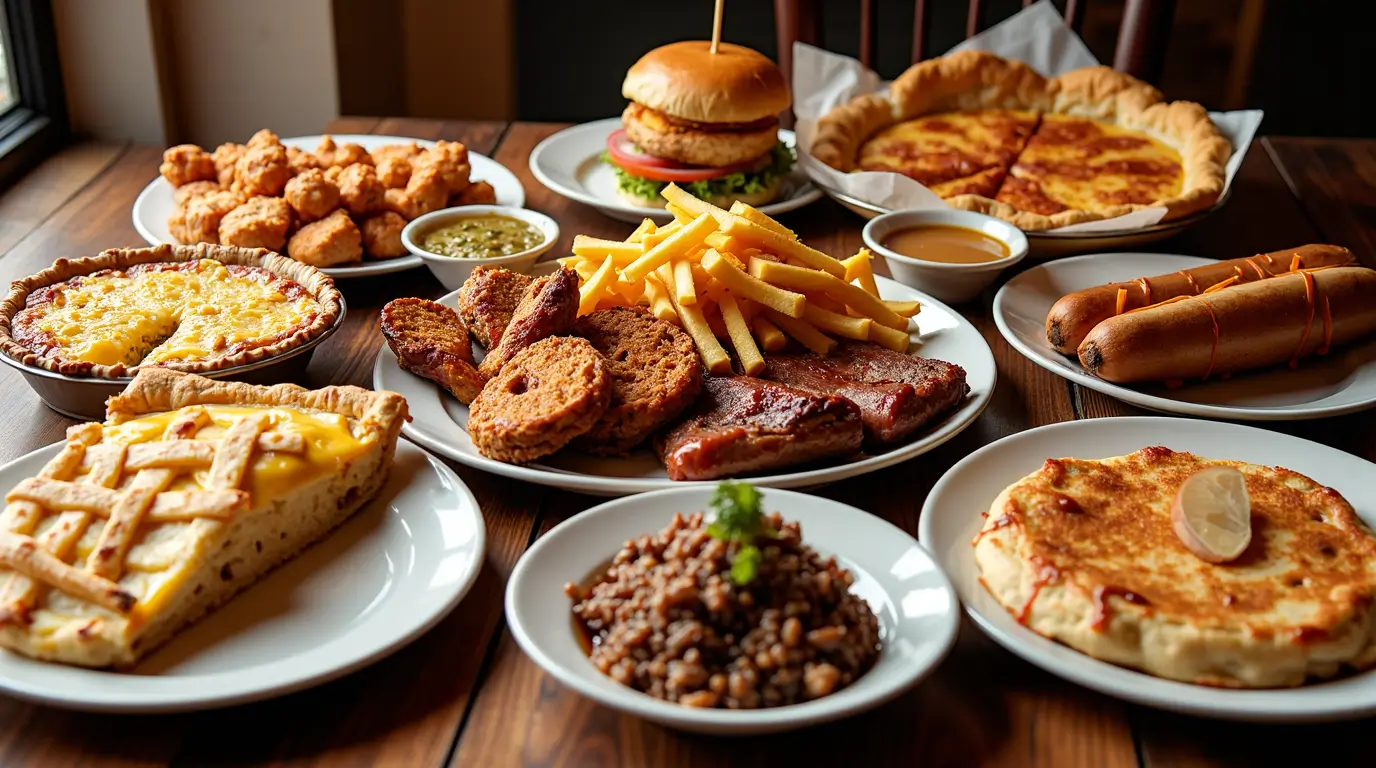Table of Contents
Table of Contents
Introduction
The cuisine of the United States is as vast and varied as the country’s landscape. Its gastronomic traditions have been shaped by waves of migration, cross-regional exchanges, and an ever-evolving national identity. Spanning the entire North American continent from sea to shining sea (and beyond, when including Hawaii and Alaska), the United States boasts a wide assortment of climates, terrains, and cultural influences. This multifaceted context has led to a cuisine that is difficult to define simply as “American,” since it encompasses everything from Native American traditions, early British and French colonial influences, West African culinary legacies, and later waves of European and Asian immigration. Despite these diverse roots, certain unifying features still run through the nation’s kitchens and dining tables—from the love of barbecue in the South to the emphasis on fresh produce in California, or the fusion of Tex-Mex along the border states.
Understanding American cuisine means acknowledging its constant state of reinvention—an interplay between tradition and innovation, local availability and global trade, small-town diners and Michelin-starred city restaurants. To fully appreciate it, one must trace its development through historical milestones, examine the ingredients that define it, explore regional distinctions, and delve into the customs and rituals that color day-to-day meals. This article will present not just the nation’s celebrated dishes, but also its culinary ethos, table traditions, and modern trends, offering readers an expansive look at what American cooking is all about.
Culinary Context and History in the United States
Development Over Time
The culinary history of the United States can be divided into several broad periods. Initially, Native American communities cultivated a diet based heavily on locally available foods, including corn, beans, squash (often called the “Three Sisters”), game meats, fish, wild plants, and fruits. Techniques such as smoking, drying, and roasting were common, and every region had its own approach to cooking based on environmental resources—salmon in the Pacific Northwest, bison on the Great Plains, or shellfish and crustaceans along the East Coast.
Colonization, particularly by the British, French, Spanish, and Dutch, forever altered local eating habits. European settlers brought livestock (cattle, pigs, chickens) and non-native plants (wheat, apples, onions) while adopting certain Native American ingredients—most notably corn, which profoundly influenced new-world diets. Over time, enslaved Africans introduced ingredients like okra, black-eyed peas, yams, and cooking methods that shaped Southern cuisine. The mixture of African, European, and Indigenous traditions would later become the backbone of what we often call “soul food,” particularly associated with the American South.
Subsequent waves of immigration in the 19th and 20th centuries—Italian, German, Irish, Chinese, Japanese, Mexican, and more—further expanded the national palate within the United States. Dishes like spaghetti and meatballs, bagels and lox, fortune cookies, and tacos have become as American as hamburgers and apple pie. Indeed, food historians often emphasize that the very identity of American cuisine is in its capacity to absorb and localize recipes from around the globe. The industrial revolution, urbanization, and advances in food processing—from canning to fast-food franchising—have all contributed to how Americans eat. Post-World War II affluence turned the refrigerator into a standard kitchen appliance and the supermarket into an American institution, reshaping shopping habits and cooking routines.
Historical, Cultural, and Geographical Influences
The geographical spread of the United States, from the glaciers of Alaska to the tropical climate of Hawaii, also means that local produce changes dramatically across regions. In the Northeast, long winters often favored preservation techniques like pickling and salting, while the warm and humid climate of the South welcomed crops such as peanuts and peaches. Immigrants often settled in communities that mirrored the climates they came from, bringing with them seeds and culinary habits that thrived in similar conditions. The presence of diverse cultural enclaves in many large American cities—such as New York’s Little Italy and Chinatown, or the large Korean and Ethiopian neighborhoods in Los Angeles—remains a testament to the layered influences in the national diet.
Meanwhile, some pivotal events have left their mark on the American table. The 19th-century Gold Rush in California brought a surge in population, especially from Asia, establishing a bedrock for the state’s enduring love affair with fusion cuisine. The mid-20th-century “Great Migration” saw millions of African Americans move from the rural South to the North and West, carrying Southern dishes—like fried chicken, collard greens, and gumbo—into big cities like Chicago and Los Angeles. Over time, foods identified as Southern became mainstream American favorites.
Key Periods and Major Events
- Colonization (17th–18th centuries): Marked by European settlement, the introduction of wheat, sugar, livestock, and adoptive use of corn from Indigenous communities.
- Enslavement and African Influences (17th–19th centuries): Brought okra, black-eyed peas, and cooking styles that combined African, Native American, and European traditions into Creole, Gullah, and other regional cuisines.
- Westward Expansion and Immigration (19th–early 20th century): Shifted the American diet, introducing more grains like wheat from the plains, as well as new ethnic cuisines—German sausages, Italian pasta dishes, Chinese stir-fries—that spread along railroad routes.
- Industrial Revolution and Post-War Era: Mass production of canned goods, birth of fast-food franchises (White Castle in the 1920s, McDonald’s in the 1940s), and supermarkets becoming the norm.
- Late 20th–21st century Globalization: Increasingly sophisticated fusion cuisine, a farm-to-table movement reacting against industrial food systems, and an embrace of international flavors reflecting continued immigration.
Regional Differences
- Northeast (New England, Mid-Atlantic): Known for clam chowder, lobster rolls, baked beans, maple syrup, bagels, cheesesteaks, and a robust diner culture. Hearty foods influenced by British and Irish traditions merged with local produce.
- South (Southeastern states): Soul food, barbecue, fried chicken, grits, biscuits, gumbo, and jambalaya. Strong African American influences combine with Native American and French, particularly in Louisiana’s Creole and Cajun dishes.
- Midwest (“America’s Heartland”): Celebrated for comfort foods, casseroles, corn, wheat-based products, dairy (especially cheese from Wisconsin), and distinctive items like Chicago deep-dish pizza. German and Scandinavian influences abound.
- West and Southwest: Tex-Mex in Texas and border states, featuring chili con carne, tacos, enchiladas, guacamole; California’s fresh produce and fusion cuisine, Pacific Northwest’s salmon, berries, and coffee culture.
- Alaska and Hawaii: Alaska’s cuisine highlights salmon, reindeer sausage, and wild berries; Hawaii offers a unique mix of Polynesian, Japanese, Chinese, and American influences. Dishes like poke, Kalua pork, and SPAM musubi reflect this blend.
Key Ingredients and Local Products Across the United States
Emblematic Foods
American cooking generally features a wide array of proteins, grains, and produce, with local specialties sometimes relying on very region-specific items. Some key ingredients include:
- Corn: Used in countless ways—cornbread, cornmeal for tortillas (especially in the Southwest), grits in the South, and sweet corn on the cob.
- Wheat: The basis for breads, pastries, pasta, and more. The American Midwest, often referred to as the “breadbasket,” grows vast quantities of wheat.
- Beef, Pork, and Poultry: Large-scale ranching has made beef and poultry staples across much of the country. Pork is prominent in Southern barbecue and charcuterie.
- Seafood: Clams, lobsters, cod, and crab in the Northeast; catfish, shrimp, and crawfish in the South; salmon and shellfish in the Pacific Northwest; diverse catches in Hawaii.
- Dairy: Cheese, milk, butter—thanks to robust dairy industries, especially in the Midwest.
- Vegetables and Fruits: Regional favorites include collard greens, okra, peppers, tomatoes, sweet potatoes, apples, blueberries, peaches, and citrus in warmer climates.
- Spices and Herbs: While American cuisine can be mild, certain regions incorporate bolder seasonings, such as chili peppers in the Southwest and Creole seasoning in Louisiana.
Seasonality and Its Impact
Traditionally, cooking throughout the United States was quite seasonal: root vegetables and preserved foods in cold climates during winter, fresh berries and salads in summer, etc. Over the 20th century, the rise of supermarkets offering year-round produce changed this habit. Yet, the farm-to-table movement of recent decades has rekindled an appreciation for local, seasonal food. Certain regions, especially California, produce abundant crops year-round, influencing local chefs to prioritize fresh fruits, vegetables, and herbs.
Tips on Purchasing Ingredients in the United States
For those seeking to recreate American dishes abroad:
- Local Markets: Farmers’ markets can be a great place to find fresh produce, dairy, or artisanal breads reminiscent of American “country style” markets.
- Specialty Stores: Shops that stock international products often carry American snacks, baking ingredients (like cornmeal, molasses, or specific flours), barbecue sauces, peanut butter, etc.
- Online Retailers: Many American brands—from spices to canned pumpkin for pies—can be ordered online and shipped worldwide.
- Substitutions: If certain items (like collard greens) are unavailable, consider using kale or spinach for similar results. Okra might be harder to source but is often found in African, Caribbean, or Asian markets.
Must-Try Traditional Dishes in the United States
Iconic Dishes to Experience
Apple Pie

Often hailed as the quintessential American dessert. Traditionally made with a flaky, buttery crust and sweet-tart apples, it symbolizes homestyle comfort and national pride.
Hamburger

Though its origins may be tied to German immigrants (Hamburg), the modern burger is a fixture of American diners, backyard barbecues, and fast-food chains. Variations abound, from classic cheeseburgers to gourmet versions topped with artisanal cheeses and exotic sauces.
Hot Dog

Another dish linked to German immigrants, hot dogs are sausages typically served in a soft bun with condiments like mustard, ketchup, relish, or sauerkraut. They’re particularly associated with baseball games, summer cookouts, and street carts in major cities.
Gumbo and Jambalaya (Louisiana Specialties)

Creole and Cajun stews loaded with shrimp, sausage, chicken, peppers, and okra, served over rice for gumbo, or cooked together with the rice for jambalaya.
Bagels and Lox (Northeast)

Brought by Eastern European Jewish immigrants, bagels topped with smoked salmon and cream cheese remain a breakfast and brunch favorite.
Simplified Recipes
Simple Apple Pie (Home-Style)
Ingredients
- 2 rolled pie crusts (store-bought or homemade)
- 6 large apples (like Granny Smith), peeled and sliced
- 3/4 cup granulated sugar
- 1 teaspoon ground cinnamon
- 1/4 teaspoon nutmeg
- 2 tablespoons all-purpose flour
- 1 tablespoon lemon juice
- 1 tablespoon butter, cut into small pieces
- 1 egg, beaten (for brushing)
Instructions
- Preheat oven to 375°F (190°C).
- Line a pie dish with one crust, allowing the edges to slightly overhang.
- In a large bowl, mix the apple slices with sugar, cinnamon, nutmeg, flour, and lemon juice.
- Pour the apple mixture into the crust and dot with butter pieces.
- Cover with the second crust. Pinch the edges together and cut a few slits on top for ventilation.
- Brush the top crust with beaten egg for a golden finish.
- Bake for about 45–50 minutes, or until the crust is golden and the filling is bubbling.
- Let cool slightly before serving.
Basic Southern-Style Fried Chicken
Ingredients
- 8 pieces of chicken (thighs, drumsticks, breasts)
- 2 cups buttermilk
- 2 cups all-purpose flour
- 1 teaspoon salt
- 1 teaspoon black pepper
- 1 teaspoon paprika
- 1/2 teaspoon cayenne pepper (optional for heat)
- Vegetable oil for frying
Instructions
- Place chicken pieces in a large bowl and pour over the buttermilk, ensuring they are fully coated. Marinate for at least 2 hours, or overnight.
- In another bowl, mix flour, salt, pepper, paprika, and cayenne (if using).
- Heat about 1 inch of oil in a cast-iron skillet or deep pan to 350°F (175°C).
- Remove chicken from buttermilk, letting excess drip off. Dredge in the flour mixture until well coated.
- Fry chicken in batches, about 15–18 minutes total, turning occasionally to brown evenly.
- Drain on paper towels and serve hot.
Regional Variations
Taking fried chicken as an example, recipes differ based on marinade (some use pickle juice, others a spice-heavy rub). Barbecue styles vary widely across the United States: Memphis is known for dry rub ribs, Carolina for vinegar-based pulled pork, and Texas for beef brisket. Even apple pie can change from region to region, with crumb toppings or cheddar cheese slices popular in certain locales. These variations highlight the adaptability and regional pride behind American staples.
Defining Characteristics of This Country’s Cuisine
In such a large country, describing a single characteristic for all American cuisine is challenging. However, a few themes emerge:
- Diversity and Fusion: American cuisine is a mosaic of global influences. Whether it’s a Korean taco truck in Los Angeles or a Texan steakhouse, flavor combinations often borrow from different culinary traditions.
- Generous Portions and Comfort Food: From diners to holiday tables, there’s a tendency towards hearty, satisfying dishes—like mac and cheese, meatloaf, or mashed potatoes.
- Variety of Flavors: While not universally “spicy,” you’ll find regions (like the Southwest or Louisiana) that excel in bold seasonings. Meanwhile, Midwestern cooking can be mild and centered around hearty staples like casseroles. Sweet, salty, sour, and spicy often coexist across the country, reflecting different regional tastes.
- Condiments and Sauces: Americans love sauces, from ketchup and ranch dressing to barbecue sauces of all kinds. Condiments are a key part of the flavor profile, allowing individuals to tailor dishes to their preferences.
Because of these defining traits, American cuisine appeals to food lovers seeking comfort, variety, creativity, and a sense of familiarity with a twist. The hallmark is the lack of strict rules—chefs and home cooks alike experiment constantly, pushing the boundaries of tradition.
Tips and Highlights to Encourage People to Try This Cuisine in the United States
- Cultural Mosaic: Exploring American food is like taking a gastronomic tour of the world, thanks to the myriad influences that converge in popular dishes. You’ll find flavors from Italy, Mexico, China, and West Africa, all integrated into local culinary habits.
- Regional Adventures: Each region offers something unique—crab cakes in Maryland, gumbo in New Orleans, deep-dish pizza in Chicago, Tex-Mex in San Antonio, salmon in Seattle, poke in Hawaii. This variety alone makes American cuisine exciting to discover.
- Comfort Factor: Many American dishes are designed for sharing and communal enjoyment. Think backyard barbecues, potlucks, Thanksgiving feasts—these experiences speak to conviviality and warmth.
- Endless Innovation: From food trucks to Michelin-star restaurants, contemporary American cuisine is constantly evolving. Anyone looking to try new flavors and see culinary creativity at work will appreciate the excitement in American dining.
Anecdotes also abound throughout the United States: from the birth of the hamburger at the 1904 World’s Fair in St. Louis (as some claim) to the invention of Buffalo wings in a bar in Buffalo, New York, American cuisine is filled with stories of humble origins that turned into nationwide phenomena. These narratives add a sense of adventure and historical curiosity when sampling new dishes.
Table Rituals and Customs
Typical Meal Structure
Traditionally, many Americans observe three main meals:
- Breakfast: Can range from a quick grab-and-go (coffee and a bagel) to a hearty spread (eggs, bacon, pancakes, or biscuits and gravy in the South). In many households, weekday breakfasts might be simple (cereal, toast), while weekend brunches are more elaborate.
- Lunch: Often eaten around midday, frequently featuring sandwiches, salads, or soups. Office workers might opt for a quick bite or bring leftovers from home.
- Dinner (Supper in some regions): Typically the largest meal of the day. It might be served relatively early by global standards (anywhere from 5:30 PM to 8:00 PM). Family dinners are a central tradition in many households, especially around weekends or holidays.
An “aperitif” isn’t standard in the United States like it is in some European countries, but having a drink before dinner (a cocktail or beer) is common, especially at social gatherings. Afternoon snacks, especially for children, are typical—cookies, fruit, or crackers—though “afternoon tea” in the British sense is less common.
Table Etiquette and Customs
- Cutlery: Americans generally use a knife in the right hand and fork in the left when cutting, then switch the fork to the right hand to eat—commonly referred to as the “American style” of dining.
- Casual Atmosphere: In many households, formality is minimal. However, certain upscale restaurants or special occasions (like Thanksgiving or a wedding dinner) call for more traditional table manners.
- Tips and Gratuities: In restaurants, tipping servers (usually around 15–20% of the bill) is customary and expected, as wages are often structured around gratuities.
- Sharing and Potlucks: For casual gatherings, potlucks—where each guest brings a dish—are common. This highlights the social aspect of American dining, where variety and generosity are prized.
- Gestures to Avoid: Generally, overt slurping or burping at the table is considered impolite. Playing with utensils or pointing them at others may also be frowned upon.
National Holidays and Celebrations
- Thanksgiving (Fourth Thursday of November): Perhaps the most food-centric holiday, featuring turkey, stuffing, cranberry sauce, mashed potatoes, and pumpkin pie. The meal commemorates the historic harvest feast shared between Pilgrims and Native Americans (though that narrative is also scrutinized for historical accuracy).
- Fourth of July (Independence Day): Cookouts and barbecues reign, with hot dogs, hamburgers, potato salads, and watermelon. Fireworks and red-white-and-blue themes abound.
- Christmas and Other Winter Holidays: The culinary traditions echo Thanksgiving in some households, but with variations like ham or roast beef. Christmas cookies and eggnog are widespread.
- Regional/Religious Celebrations: Mardi Gras in New Orleans sees King Cake, while certain Jewish holidays might feature American twists on traditional dishes, such as bagels and lox for break-the-fast meals after Yom Kippur.
Family celebrations often center on large home-cooked meals, reinforcing the idea of food as a unifying force in American culture.
Modern Trends and Culinary Fusions in the United States
Evolving Through Contact with Other Gastronomies
In large multicultural cities across the United States, you’ll find endless examples of fusion. Korean-American chefs have popularized kimchi tacos and bibimbap burritos. Filipino-American chefs have introduced adobo-inspired dishes in modern American brunches. Japanese ramen shops have taken off in cities across the nation, frequently mixing local ingredients (like smoked brisket) into the broth. This cross-pollination is a testament to America’s ongoing role as a melting pot, where immigrants continue to shape the future of the cuisine.
New Consumption Trends
- Farm-to-Table and Locavorism: Chefs and restaurants increasingly source ingredients from nearby farmers to ensure freshness and sustainability. This movement is particularly strong in states like California, Vermont, Oregon, and Washington.
- Vegetarian and Vegan Options: A growth in plant-based diets has led to creative interpretations of classic dishes—vegan burgers with meat-like patties, dairy-free mac and cheese, cauliflower “wings,” etc.
- Organic and Non-GMO Foods: Some consumers prioritize organic labeling, or look for non-GMO grains and produce, reflecting a concern about health and environmental impact.
- Gluten-Free and Allergen-Friendly Menus: As awareness of food allergies and intolerances has grown, many restaurants across the country offer gluten-free bread, dairy-free desserts, and peanut-free kitchens.
Young Chefs and Restaurateurs
In the United States, a new generation of American chefs often trained abroad in European or Asian kitchens are bringing those experiences back home. They reinterpret regional classics by using avant-garde techniques—think sous-vide barbecue or molecular gastronomy twists on chicken and waffles. Others emphasize community-based dining, casual pop-ups, and collaborative tasting events that blur the line between chef and patron. These young innovators are rewriting the rules, but still paying homage to local ingredients and culinary legacies.
Conclusion and Call to Action in the United States
American cuisine, shaped by centuries of cultural exchange, regional distinctions, and modern innovations across the United States, offers an astonishing range of flavors and experiences. From the earliest Indigenous foodways to the contemporary fusion dishes enjoyed in the biggest cities, it has proven itself to be both steeped in tradition and open to constant reinvention. Whether you’re savoring a classic apple pie or a cutting-edge farm-to-table creation, you’re participating in a culinary heritage that reflects the country’s diversity, resilience, and creativity.
If you’ve never sampled the variety of regional barbecue styles or the eclectic brunch culture that merges comfort food with international influences, make the leap and explore the possibilities. Try recreating the simplified recipes provided above—bake an apple pie, fry up some chicken—and share your experiences with friends and family. Don’t forget to experiment with local ingredients and adapt recipes to your own tastes. Part of the magic of American cooking is its capacity to evolve in new hands and new kitchens.
We’d love to hear about your favorite American dishes, family recipes, or any questions you might have about sourcing ingredients and experimenting with flavors. Join the conversation by sharing your own tips, experiences, and culinary successes. And if you’re curious about another angle on American gastronomy, stay tuned for our future article on the fascinating and sometimes surprising world of regional desserts and sweet treats—from Key lime pie in Florida to Huckleberry dishes in Montana. There’s always more to discover in the ever-evolving tapestry that is American cuisine.

